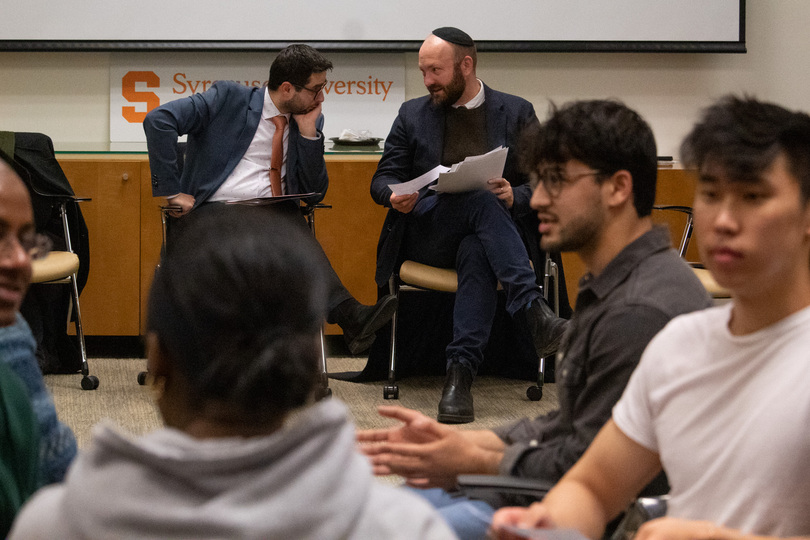Hendricks Chapel promotes Jewish-Muslim dialogue at interfaith speaker event

Cassandra Roshu | Photo Editor
Imam Amir Durić and Rabbi Ethan Bair facilitated interfaith discourse during "Taste of Dialogue: Empathy and Ethics in Judaism and Islam.”
Support The Daily Orange this holiday season! The money raised between now and the end of the year will go directly toward aiding our students. Donate today.
Hendricks Chapel Chaplains Imam Amir Durić and Rabbi Ethan Bair hosted around 30 Syracuse University faculty, staff and students in Bird Library to discuss the shared experiences of Jewish and Muslim communities.
At “Taste of Dialogue: Empathy and Ethics in Judaism and Islam,” attendees of several religious backgrounds had open discussions with the chaplains, highlighting the importance of empathy and solidarity within the core tenets of both religions.
Bair said he wanted to emphasize that the event was not about the “political situation” in the Middle East, referring to the ongoing Israel-Hamas war. Instead, he said the purpose of the discussion was to build understanding and connections between the two religions.
“This semester was a really hard time to be a Jew and to be a Muslim on all college campuses,” Bair said. “The purpose of tonight is really building a bridge between our two communities.”
He said Jewish students approached him this semester and expressed a desire to learn more about Islam to better understand the perspective of Muslim students on campus. He also said the talk will serve as a model for a new “Jewish-Muslim dialogue fellowship” — a four-part series of conversations featuring nine Jewish and nine Muslim student fellows starting next semester.
Throughout the talk, Bair and Durić presented topics that Bair said are “core to the Muslim and Jewish experience in the U.S.,” such as family stories surrounding immigration. They both shared their perspectives before opening the floor to attendees.
Durić, who immigrated from Bosnia in 2009, said he grew up in a community with several families who came to the U.S. during the Bosnian genocide. Though Durić wasn’t a refugee, growing up in the community inspired him to support those who experienced genocide, he said. He also described some instances where he felt discriminated against as a Muslim and an immigrant.
“I feel American, but there are times when people question that,” Durić said.
After asking a few introductory discussion questions, Bair and Durić transitioned into comparing Judaism and Islam’s respective religious texts: the Torah and the Quran.
They introduced four excerpts, two from each book, all dealing with themes of empathy. They contextualized the pieces before splitting attendees into groups, encouraging them to work with someone from a “different background” than their own.
“That’s the thing about empathy — it requires effort,” said Cornell Perry, a sophomore, during a breakout discussion. “There are always two sides to every story.”
Perry also said that although the discussion questions were “tough,” he believed they were crucial in establishing empathy and understanding on campus.
As discussions continued, attendees reviewed prewritten discussion topics that coincided with the content of the religious passages. Outside of the topics on the page, many attendees introduced themselves and shared their reasons for attending.
Dr. Zachary Braiterman, professor of religion and director of the Jewish studies program, said he attended the event after hearing about it from Bair. Braiterman said finding similarities between the Torah and Quran is a common trend in Jewish-Muslim discourse.
“They’re two communities who are drawn together by any number of reasons, some of them painful,” Braiterman said. “A lot of the painful stuff gets displaced by talking about texts.”
Braiterman said events like Wednesday’s are a valuable way to “humanize” groups during ongoing tension.
“(Bair and Durić) really model how Jewish and Muslim relations should be. They’re just a great model for friendship, empathy and recognition,” Braiterman said. “We’re really lucky to have them here.”
After each text, the group reconvened, sharing what they talked about in their smaller discussions. Throughout the night, attendees emphasized connections between Islam and Judaism, such as linguistic similarities between Arabic and Hebrew and shared stories between their respective religious texts.
Another student, Jada, a senior communication and rhetorical studies major who wished to be referred to by her first name, said she was inspired to attend the event because of the misinformation on social media regarding the recent conflict.
“I just wanted to make myself more knowledgeable,” she said during another breakout discussion. “I thought it would be nice to actually hear from people that are part of these communities.”
At the end of the talk, attendees shared their personal takeaways from each text. Several students said they believed the event was a “refreshing” way to introduce these conversations on campus.
“I found it very enlightening,” said one attendee — a Muslim student who will serve as one of the Jewish-Muslim dialogue fellows next semester.
The student, who asked to remain anonymous, said they decided to attend after Durić encouraged them to do so, as it would prepare them for the fellowship events next semester. They said they were glad the event allowed them to meet people from other communities on campus as well as “compare and contrast” their religion with Judaism.
“At the end of the day, we’re all students with curious minds,” the student said. “By engaging in these conversations, we’re actively lessening our ignorance and expanding our little bubble.”
Similar to the format of the “Taste of Dialogue” talk, future “Jewish-Muslim dialogue fellowship” events will review texts, foster relationships between communities and explore the connections between Judaism and Islam, Durić and Bair said.
“It’s going to be crucial for us to create spaces and opportunities like this one, to come together, because it’s easy to dismiss other people,” Durić said. “That will only be possible if we spend time and try to understand different perspectives.”





